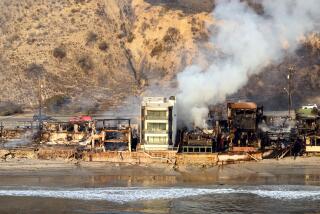L.A. earthquake safety plan for vulnerable buildings advances
- Share via
A Los Angeles City Council committee agreed Tuesday to push forward a proposal to identify all the apartment buildings in the city that have a certain type of wood frame that is vulnerable to collapse in a major earthquake.
Reporting to a City Council planning committee, Ifa Kashefi, chief of the engineering bureau at the Department of Building and Safety, laid out a plan to winnow out these so-called soft story wood-frame buildings among the 29,000 apartment buildings across the city that were built before 1978.
Kashefi’s report was in response to a motion filed by Councilman Tom LaBonge. With two building inspectors and a structural engineer on the job, sorting through the inventory would take at least a year. The department could complete the task sooner if more funding and staff was assigned, Kashefi said.
“I’m all for moving this forward and ensuring that this is a priority in the city,” said council committee member Mitch Englander, who had seconded LaBonge’s motion. “There’s no question that we’ve got a serious issue, and we can’t simply dig a hole and put our head in it and pretend it’ll go away.”
FULL COVERAGE: California quake safety
Officials have long known about the risk of soft-story buildings, particularly after the 1994 Northridge earthquake, when about 200 of these structures were seriously damaged or destroyed, and 16 people died in the Northridge Meadows apartment complex.
Soft-story structures are often built over carports and held up with slender columns, leaving the upper floors to crash into ground-floor apartments during shaking. No city data exist to easily identify which structures are wood-framed and soft-story, Kashefi said.
The city’s housing department provided addresses for 29,226 apartment buildings in the city built before 1978, according to Kashefi’s report. Staffers would then use mapping programs to narrow down which apartment buildings need further field inspection.
Kashefi’s staff did a “pilot program” with a sample group of buildings, she said. They were able to estimate that 20% of the 29,226, or about 5,800 buildings, will be soft-story buildings, and an additional 11,690 buildings will need to be inspected on site to determine whether they are soft-story buildings.
The report provided a sample checklist of things an inspector would look for in surveying these buildings. Each inspector would be able to examine about 30 buildings per day, according to the report, and the overall inventory would take about one year and several months if two inspectors and one structural engineer worked on this task.
The motion, introduced in July by City Councilman Tom LaBonge, asks building officials to present a proposal for how the city would be able to identify wood-frame soft-story residential buildings with at least two stories and at least five units that were built before 1978.
LaBonge’s motion came after San Francisco passed a landmark earthquake safety ordinance this year that requires about 3,000 wooden apartment buildings to be strengthened.
Concerns about costs thwarted earlier efforts in L.A. to identify and force property owners to retrofit their buildings. Many owners said they shouldn’t have to pay for expensive fixes on their own.
Beverly Kenworthy, executive director of the Los Angeles division of the California Apartment Assn., told the City Council committee that costs are a concern but her group wants to work with city officials on retrofit efforts.
“The safety of tenants is the utmost importance to our members,” said Kenworthy, who added that San Francisco successfully worked with her association to develop a retrofit policy.
While the inventory proposal is being considered, Englander said he’s interested in creating a task force that would look at incentive programs for retrofitting, such as tax credits.
Other committee officials said Tuesday that the inventory effort needs to be considered in context with the other retrofit-related motions that are pending and would also need funding.
Englander and LaBonge had also submitted a motion in October to look into cataloging the city’s old concrete buildings, which are vulnerable to the sideways movement of a major earthquake because they don’t have enough steel reinforcement to hold columns in place.
Experts say sorting out which concrete structures present the greatest danger of injury and death to occupants is a daunting problem that would require building-by-building assessments by engineers.
Englander told his colleagues that Tuesday’s discussion was long overdue.
“I would ask that we begin this process,” Englander said. “We’ve got to look at this as not just a cost to building owners, but the cost of saving lives.”
The concrete building motion will be discussed by the planning committee. The committee Tuesday moved the soft-story motion to be presented to the full City Council in January. The committee directed the city administrative officer to report back on funding options based on Kashefi’s report, which will also be presented in January.
ALSO:
IN DEPTH: Concrete buildings across L.A. are at risk
San Francisco offers lessons to L.A. on quake retrofitting
Identifying apartments at risk in quakes could take more than a year
Twitter: @RosannaXia
More to Read
Sign up for Essential California
The most important California stories and recommendations in your inbox every morning.
You may occasionally receive promotional content from the Los Angeles Times.











